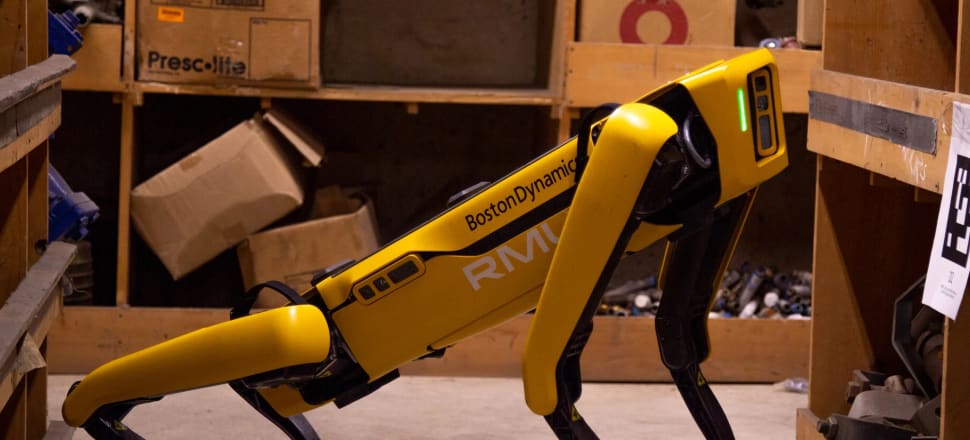
A 5G mobile network offers faster mobile speeds than 4G and more capacity for the increasing demand for data on Spark’s network, which grows by about 40 percent every year | Content partnership
Three years after Spark started rolling out its 5G mobile network the rubber is really hitting the road, and the company’s guiding kaupapa – Hello Tomorrow – embodies its relentless optimism for the future, using technology as the vehicle to unleash an Aotearoa that’s full of possibilities.
The acceleration of growth in digital infrastructure and emerging technologies gives us a glimpse into a diverse and exciting future – from connecting us in new ways to helping us to become more productive and sustainable. It’s showing us what’s possible across all sectors including energy, arts, transport, food, forestry, agriculture, and even robotics …
Take Spot, the robot dog. Spot is clever. He can walk around an industrial site, over rubble, across a plank bridge. He monitors for rust on a pipe, reads a gas gauge, hovers over a pool of liquid on the floor, investigates a possible breach in the fence. As he moves, Spot is creating a 3D digital version of where he is, and sending it back to HQ.
READ MORE: * Spark ignites a push to net zero * Spark goes ‘all in’ on bridging digital divide
The problem is that creating that real-time, moving, digital picture requires a massive amount of data going wirelessly between Spot and the office. And that’s not feasible with today’s mobile technology.
To transmit all that data now, it has to be compressed, uploaded, sent across and then downloaded at the other end. With 4G, it might take half an hour before anyone can get access to Spot’s information about the construction site.
But with 5G, you could do that all completely live. If a remote operator wants to get a live-streamed digital reconstruction of the environment the robot is in, they need a 5G network.
5G is the fifth-generation mobile network – and it’s now available in more than 50 locations around Aotearoa, as far north as Paihia and as far south as Bluff.
It will eventually be so widespread that most Kiwis will connect to 5G instead of 4G, which is what the vast majority of us use at the moment to make our phones – and other devices – work.
5G offers faster mobile speeds than 4G and more capacity to cater for the increasing demand for data on Spark’s network, which grows by about 40% every year.
The astonishing diversity of 5G
Spot is controlled by the robotics platform that took out top spot for Spark’s 5G Starter Fund which was all about showcasing Kiwi innovation and enabling future uses of 5G.
Another remarkable application of 5G is oDocs Eye Care, which has developed a lens-enabling smartphone to turn into an affordable, portable, eye disease diagnostic tool. oDocs uses 5G to allow real-time video consultations from health workers in remote eye clinics to specialists in big city hospitals.
Then there’s virtual reality game studio Beyond which uses high-speed 5G in part to solve the latency problems which enabled remote players on their mobiles to get in on the VR game action with their friends.
Robots, blindness, gaming. The three applications for 5G are totally different, and the more than 200 companies pitching into the 5G Starter Fund showed the astonishing diversity of potential uses for 5G, says Spark technology director Mark Beder.

5G doesn’t just offer faster internet, but more internet
Spark has already connected more than 50 locations to 5G, including parts of Auckland, Christchurch, Dunedin, Hamilton, Wellington, Palmerston North, Whangārei, Tauranga and Kaikoura with more to come next year.
Here’s where it gets technical. Right now, Spark’s 5G network operates on what’s known as ‘non-standalone’ – 5G technology overlayed on top of existing 4G cell-sites, but still using the 4G core infrastructure.
Non-standalone 5G is a big step up from 4G, but there’s still more that can be done. The end goal of 5G is ‘standalone’ – where we would deploy an end-to-end 5G network, rather than using 4G for core infrastructure.
Spark started trialling the standalone technology in October running two proof-of-concepts with technology providers Mavenir and AWS and it intends to continue trials next year.
The technology unlocks a range of new configurable capabilities like network slicing and multi-access edge compute (more on those below). These capabilities will be rolled out to areas where there’s demand and benefit for the services, such as industrial zones.
A future where you can connect to pretty much anything
As 5G gets bigger and better and then as standalone 5G becomes available, more and more devices will be able to be connected, and not just the sort of devices we are used to (phones and laptops, for example), but lots of other previously unconnected things.
What if every streetlamp had sensors so they turned off when there was no one around?
Or imagine millions of household gadgets connected in real time to the electricity network so they could be used to reduce load at periods of peak usage – fridges where the temperature went up a notch for an hour or so, heat pumps that turned themselves down a bit.
It’s what the Internet of Things (IoT) is all about – smart, web-connected, data-producing machines.
Of course, it’s happening already. Food producers connecting up their cold stores with sensors to monitor the temperature, even when no one’s at work. The boss of an automated manufacturing plant being able to keep an eye on production 24/7, as well as check wear and tear on the machines. A security firm able to get high-quality, near real-time footage from surveillance cameras, plus alerts if sensors detect something seems to be wrong.
Last month, Spark connected the one-millionth new “thing” to its IoT network, Beder says.
“The future is going to be where you can have connectivity to pretty much anything.”
Which is where 5G comes in. The 4G network will only be able to cope with so many connected devices, Beder says. A 5G network will be able to handle far, far more.
Life and death applications of 5G
Another thing that will happen is that standalone 5G will enable ‘multi access edge compute’. That’s about taking the grunty processing parts of the mobile network out to the edges of the network.
That means data doesn’t have to travel so far to get to a processing node, speeding up the connection, freeing up space on the main network, and bringing big reductions in what’s known as latency, Beder says.
It sounds technical, but latency is basically delay, or lag. Low latency means very little lag. The aim is to get it as close to real time as possible.
In virtual reality gaming, for example, the lower the latency, the less likely a player will get motion sickness.
But there are more life-and-death-critical applications.
Health and safety on construction sites is a good example and this was put to practice during Spark’s first 5G Multi Access Edge Compute pilot with EnviroNZ in July. Using computer vision and IoT video cameras, the 5G-powered hazard detection system identifies and tracks people and excavators within a specified detection zone and calculates distances between them at a busy resource recovery centre.
To help explore the potential of Multi Access Edge Compute within this pilot, the EnviroWaste video feed is transmitted over 5G connectivity to the cloud-based application hosted at the edge in real time.
The added benefit of adding edge compute to this mix allows data to transfer more quickly back to the cloud-based application to the 5G connected video camera, and therefore for hazards to be flagged more quickly – making it less likely a serious accident will occur on site.
A new world of real and amazing possibilities – Hello Tomorrow
As Spark continues the development of its 5G standalone network capability, this will unlock some of the most exciting and transformative features of 5G.
We saw this in August when Spark launched New Zealand’s first interactive 5G Street Museum to the public across streets in Auckland, Hamilton, Wellington, Christchurch, and Dunedin – a co-created series of 5G-powered augmented reality (AR) experiences that brought to life unseen stories of some of our nation’s most iconic creatives: Parris Goebel, Benee, David Dallas, Teeks, and Askew One.

Spark’s 5G St Museum has enabled these world-class creators – artists, dancers and singers – to explore entirely new ways of expressing themselves and in turn, with the speed and capability of 5G, offer their audience a new, immersive way to engage with them at scale and in the highest definition possible.
Another example of what’s possible with 5G is ‘Network slicing’, which is a way of tailoring the network so that slices can be split off for specific customers or uses.
There are plenty of organisations for whom a sliced network will be a godsend.
Take a port – a smart, automated port of the future. It might have autonomous vehicles scooting around loading and unloading. It might have asset tracking sensors on its containers, and high-resolution security cameras to monitor safety exclusion zones.
This port could use a ‘slice’ of the 5G network tuned for ultra-reliability to make sure the internet connection for those critical parts of its business never goes down. But emails going out from the office and social media logins from the lunchroom aren’t so important – they could be on a cheaper slice.
“5G standalone could dedicate one ‘slice’ of the 5G network to the automation of critical machinery on site, with ultra-low latency and reliability being the core requirements of the network,” Beder says.
“Another ‘slice’ of the network could be dedicated to connectivity for workers to access emails and conduct other business with different and less critical requirements.”
Spot, the robotic dog, may seem like something out of a sci-fi story to some – but he represents a new world of real and amazing possibilities, channelling Spark 5G to propel New Zealand businesses and households into the future via a mobile network built for tomorrow.
Spark is a foundation partner of Newsroom.co.nz







